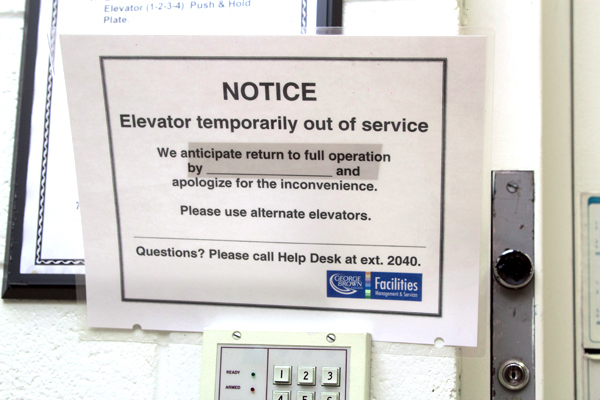I was surprised by the sight that greeted me when I pushed through the double doors of St. James campus the morning of the first day of school while intending to purchase my textbooks before heading to the library to check my email.
The reason for my surprise is that if I was a student who uses a mobility device, it would have been impossible for me to carry out this simple back-to-school routine.
The lift that links the bookstore level of the campus with the level where the library is located was out of service. Even worse, there was no record on the out-of-service sign saying how long the lift had been broken or when it would be fixed.
Had I been a first year student confronted with this sight, my initial impressions of George Brown would have been less than flattering.
Students at George Brown College (GBC) are always assured of the college’s accessibility. There is even a special orientation prospective students with disabilities can attend in order to learn how GBC will ensure that they have an equitable chance at success compared to their able-bodied peers.
Because I have the privilege of not needing a mobility device, I was able to navigate the few small steps between the two levels with ease. However, the image of the non-functioning lift with the undated repair sign at the entrance of the colleges’ busiest campus remained in my thoughts throughout the day.
The broken lift was a visible reminder of the ugly chasm between rhetoric and reality when it comes to the colleges’ lofty claims of accessibility and compliance with the Accessibility for Ontarians with Disabilities Act (AODA).
Enacted in 2005, the Act is described by the Ministry of Economic Development, Employment and Infrastructure as “laying the framework for the development of province-wide mandatory standards on accessibility in all areas of daily life.”
Though as a society, Ontario is not expected to comply fully with these standards until 2025—this was too far in the future for George Brown.
According to the college’s website’s section on the AODA, George Brown became “the first college in the province of Ontario to make several college-wide commitments that contribute to creating inclusion for everyone.”
To fulfill this commitment, the college created two official college bodies including an advisory committee which is made-up entirely of stakeholders, half of whom have disabilities themselves. The college also created the position of an AODA co-ordinator whose job requirement is “to ensure the college meets its obligations under the requirements of the AODA standards.”
Judging from the first day of the fall semester, these various bureaucratic positions have not translated into concrete changes in reality for students with impaired mobility at St. James campus. The most obvious manifestation of this sad fact is the broken wheelchair lift, revealing that the “inclusive environment” of the college does not yet include them.



